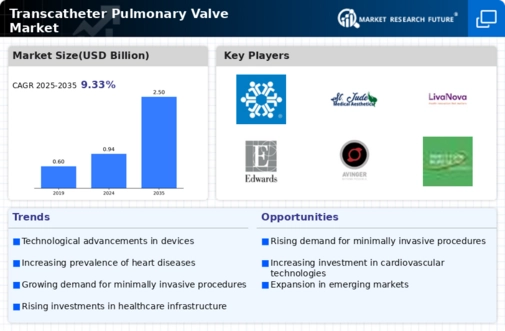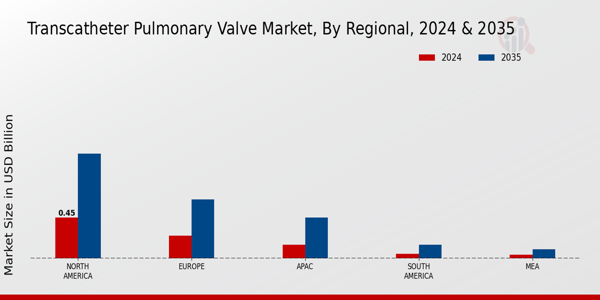Market Growth Projections
The Global Transcatheter Pulmonary Valve Market Industry is projected to experience substantial growth over the next decade. With an estimated market value of 0.94 USD Billion in 2024, it is expected to reach 2.5 USD Billion by 2035. This growth trajectory indicates a compound annual growth rate of 9.3% from 2025 to 2035, driven by various factors including technological advancements, increasing prevalence of congenital heart disease, and rising healthcare expenditures. These projections highlight the potential for significant investment and innovation within the industry, ultimately benefiting patients and healthcare providers alike.
Increasing Healthcare Expenditure
Rising healthcare expenditure across various regions is a significant driver for the Global Transcatheter Pulmonary Valve Market Industry. As countries allocate more resources to healthcare, there is a corresponding increase in funding for advanced medical technologies, including transcatheter valves. This trend is particularly notable in developed markets, where healthcare budgets are expanding to accommodate innovative treatments. The anticipated growth in market value from 0.94 USD Billion in 2024 to 2.5 USD Billion by 2035 underscores the potential for increased investment in this sector, ultimately benefiting patient access to cutting-edge therapies.
Technological Advancements in Valve Design
Innovations in transcatheter pulmonary valve technology are pivotal in enhancing patient outcomes and expanding the market. Recent advancements include the development of self-expanding valves and improved delivery systems, which facilitate easier implantation and reduce procedural risks. These technological improvements are likely to attract more healthcare providers to adopt transcatheter solutions, thereby propelling the Global Transcatheter Pulmonary Valve Market Industry forward. As these innovations gain traction, the market is projected to reach 2.5 USD Billion by 2035, indicating a robust growth trajectory driven by enhanced product offerings.
Rising Prevalence of Congenital Heart Disease
The increasing incidence of congenital heart disease globally drives the demand for transcatheter pulmonary valves. It is estimated that congenital heart defects affect approximately 1 in 100 live births, leading to a significant patient population requiring intervention. As the Global Transcatheter Pulmonary Valve Market Industry expands, the need for less invasive treatment options becomes more pronounced. This trend is likely to contribute to the market's growth, as patients seek alternatives to traditional surgical procedures. The projected market value of 0.94 USD Billion in 2024 reflects this rising demand, with expectations for continued growth as awareness and diagnosis improve.
Regulatory Support and Approval for New Devices
Regulatory bodies are increasingly supportive of the introduction of new transcatheter pulmonary valve devices, which is likely to stimulate market growth. Streamlined approval processes and favorable guidelines encourage manufacturers to innovate and bring new products to market. This regulatory environment is crucial for the Global Transcatheter Pulmonary Valve Market Industry, as it fosters competition and enhances the availability of diverse treatment options. As new devices receive approval, the market is poised for expansion, with a projected compound annual growth rate of 9.3% from 2025 to 2035, reflecting the positive impact of regulatory support.
Growing Awareness and Acceptance of Minimally Invasive Procedures
The shift towards minimally invasive surgical techniques is reshaping the landscape of cardiac interventions. Patients and healthcare professionals increasingly prefer transcatheter procedures due to their reduced recovery times and lower complication rates. This trend is particularly evident in the Global Transcatheter Pulmonary Valve Market Industry, where the adoption of these techniques is on the rise. As more clinicians become trained in these methods, the market is expected to experience a compound annual growth rate of 9.3% from 2025 to 2035, reflecting a growing acceptance of transcatheter pulmonary valves as a standard treatment option.











